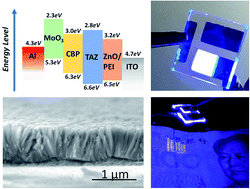Retracted Article: Wavelength modulation of ZnO nanowire based organic light-emitting diodes with ultraviolet electroluminescence
Abstract
Although organic light emitting diodes (OLEDs) can find important applications in display-related fields, it still remains a challenge to fabricate high-efficiency ultraviolet (UV) OLEDs with tunable wavelength. In this work, we demonstrate a facile method to adjust the electroluminescence (EL) peak from an inverted UV-OLED device that has zinc oxide nanowires (ZnO NWs) as an electron injection layer. The organic–inorganic interface between ZnO NWs and the 3-(4-biphenyl)-4-phenyl-5-tert-butylphenyl-1,2,4-triazole (TAZ) emission layer employed in this work allows a reduction of the diffusion length of excitons, which further results in a hampered relaxation process of higher energy states as well as a blue shift of the EL spectrum. As a result, the emission peaks of the UV-OLED can be easily adjusted from 383 nm to 374 nm by tuning both the length of the ZnO NWs and the thickness of the TAZ emission layer. Our work reveals an important correlation between emission peaks and exciton diffusion, and presents a novel approach to fabricate high-performance UV-OLEDs with the capability of facilely modifying the emission wavelength.



 Please wait while we load your content...
Please wait while we load your content...